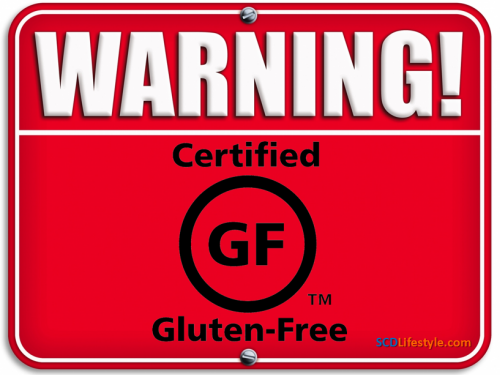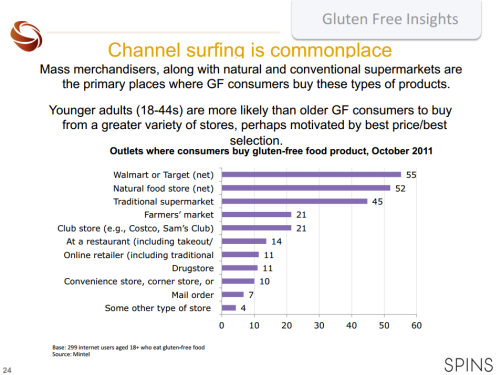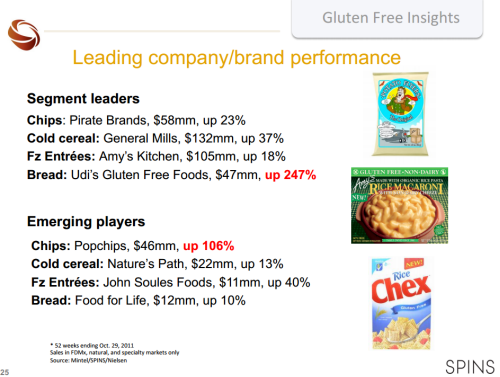The $12 Billion Gluten-Free Health Fad


When I was diagnosed with Celiac disease in 2007, I had no idea what gluten-free food was. I’d never heard of it before and I definitely didn’t know where to buy it.
But at the time, sales of gluten-free food were on the rise and had just reached $926 Million.
Fast forward to 2013, where SPINS, a market research firm that covers the natural product industry, reported a total of $12.4 billion in gluten-free sales during the 52 weeks leading up to August 4, 2012. (2)
(That’s 13.4X growth in 5 years!)
The “gluten-free” food industry is making a TON of money, while conditions like Celiac disease and gluten sensitivity are trending on Twitter and gaining more awareness each year.
TIME labeled the gluten-free movement #2 on its top 10 list of food trends for 2012…
Not only that, Domino’s now serves gluten-free pizza…
Chelsea Clinton had a gluten-free wedding cake…
Gwyneth Paltrow included gluten-free recipes in her new cookbook, and Elisabeth Hasselbeck built her “G-Free Diet” brand…
The list goes on and on.
Gluten-Free Food Isn’t Just for Health Food Stores Anymore
With the popularity soaring, the total number of innovations with gluten-free claims jumped from roughly 600 in 2007 to more than 1,600 in 2011. (3 PDF)
The FDA recently issued an official ruling to standardize what “gluten-free” labeling means in the United States, solidifying the term:
“In order to use the term ‘gluten-free’ on its label, a food must meet all of the requirements of the definition, including that the food must contain less than 20 parts per million of gluten. The rule also requires foods with the claims ‘no gluten,’ ‘free of gluten,’ and ‘without gluten’ to meet the definition for ‘gluten-free.’” (4)
Now, stores like Target and Walmart are carrying these “gluten-free” foods and capitalizing on the growing FAD. SPINS reports one survey indicated the majority of the gluten-free consumers even shopped there for food (see image below). (5 PDF)

They line the shelves with gluten-free cereal, bars, pasta, cookies, chips, sauce, bread, and pizza.
In fact, SPINS also reports the leading sales come from gluten-free chips, cereal, bread, and entrées (see image below). (6 PDF)

There’s no doubt the gluten-free industry is growing incredibly fast, reaching the $12 Billion level with continued growth projected into the future. It’s a far cry from that small section of my grocery store in 2007. On the surface, it seems like a good thing…
Especially because “gluten-free” is commonly touted as “healthy” and “good for you.”
But are gluten-free chips, cereal, bread, and entrées really that healthy?
Here’s the Rub: Gluten-Free Food Isn’t Helping Sick People
There’s no denying the fact that people with Celiac Disease or Gluten Sensitivity should avoid all gluten. Most Doctors tell them they’ll be fine if they follow a strict gluten-free diet. But how effective is the gluten-free diet for the people that need it most?
New research suggests that the small intestines of up to 60% of adults never completely heal from Celiac disease despite following a gluten-free diet. (7)
In one study of 241 Celiac patients, small intestine mucosal recovery 2 years after following a gluten-free diet was 34% and 5 years later was only 66%. (8)
The authors stated:
“Mucosal recovery was absent in a substantial portion of adults with CD after treatment with a GFD.”
Another study in 2009, published in The Journal of Alimentary Pharmacology and Therapeutics, of 465 Celiac patients after 16 months on a gluten-free diet found that:
“Complete normalization of duodenal lesions is exceptionally rare in adult coeliac patients despite adherence to GFD” (9)
So in other words, many of these people followed a gluten-free diet for years and it didn’t fix their gut. It doesn’t stop there, though…
The same 2009 study, published in the JAPT, found that 65% still had “persistent intraepithelial lymphocytosis,” a.k.a. inflammation in the gut. (10)
Even after 16 months eating gluten-free, they still had severe gut inflammation.
A 2008 study, in the Journal of Inflammation, looked at 18 symptom-free Celiac disease (SFCD) patients and found they still had elevated markers of gut inflammation even after 2 years on a gluten-free diet. The authors reported:
“Faeces of both active CD and SFCD (symptom-free 1-2 years on a GFD) patients, representing an imbalanced microbiota, significantly increased TNF-alpha production and CD86 expression in PBMCs, while decreased IL-10 cytokine production and CD4 expression compared with control samples.” (11)
Inflammation damages the intestinal lining in your gut and causes digestive problems, it can also damage the arteries in your heart and cause heart disease, and even damage your joints or cause rheumatoid arthritis. It also leads to just about every chronic disease we know of. So, it’s a pretty big deal that it’s not improving on a gluten-free diet.
What about people without Celiac Disease or Gluten Sensitivity that go gluten-free to lose weight or get more energy?
Well, new research is beginning to suggest a gluten-free diet has harmful impacts to the good bacteria in our gut.
A 2010 study, published in Gut Microbes, revealed that “the changes in the microbiota found in healthy subjects following a GFD were to some extent similar as those detected previously in patients after compliance with a long-term GFD.”
The authors went on to say that:
“…analysis of fecal microbiota and dietary intake indicated that numbers of healthy gut bacteria decreased, while numbers of unhealthy bacteria increased parallel to reductions in the intake of polysaccharides after following the GFD… individuals under a GFD would be more susceptible to overgrowth of harmful bacteria and infections, which might be associated with unpleasant symptoms and increased health risks.” (12)
Not only does the research indicate that going gluten-free doesn’t fix the gut or cool inflammation, but that it alters your gut flora and allows bad bacteria to grow in your gut.
Recent scientific breakthroughs are showing that your gut flora has the ability to communicate directly to your brain, thus affecting your moods, feeding your immune system information on how to act, and helping to control inflammation. (13) (14) (15)
Isn’t this food supposed to be healthy? Isn’t gluten a severely inflammatory toxin we should remove from our diet? Yes…
But Most Gluten-Free Food is Still Junk Food
The growing gluten-free health fad is dangerous because it’s sold as “healthy”… but the truth is most gluten-free food is still highly toxic, processed crap (even without the gluten).
Gluten is a HUGE problem for many people, don’t get me wrong… but simply switching to a gluten-free diet isn’t enough.
Most people are sold the idea that it will help them feel better, yet the research shows it’s not working as advertised. In most cases, people continue to eat the same types of food they were accustomed to eating on the Standard American Diet by simply swapping out the gluten for even more processed junk food (i.e. see my previous chart above indicating most people buy gluten-free chips, cereal, bread, and entrées ).
The problem is most gluten-free foods still contain many toxic and inflammatory ingredients that make you sicker. To sum it all up, there’s a huge difference between healthy and un-healthy gluten-free foods out there.
And to be frank: most gluten-free food isn’t “real food” at all. It’s junk food with healthy clothes on.
That’s why I was so excited to give a presentation on this topic for Sean Croxton’s Real Food Con called “The $12 Billion Gluten-Free Fad – Why It Could Be Making You Sicker.”
In my presentation, I was able to go much more in-depth on why most gluten-free food is making you sicker and what you should eat instead.
Here are a few other topics I cover:
- How to spot unhealthy “gluten-free foods” a mile away
- 4 damaging ingredients that dominate most foods labeled “gluten-free”
- Fighting the “3-headed monster” that makes gluten such a problem
If you want to check out the rest of this gluten-free story, you can watch my entire presentation for free here:
–> Watch my gluten presentation
– Jordan
Did You Like this Article?
Subscribe to our newsletter to receive email notifications, some ways to find relief, and next steps.
